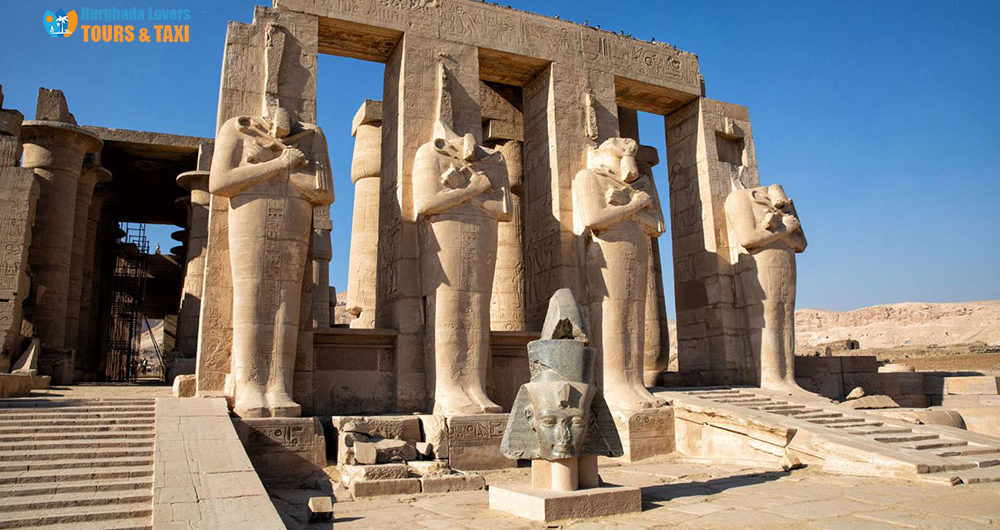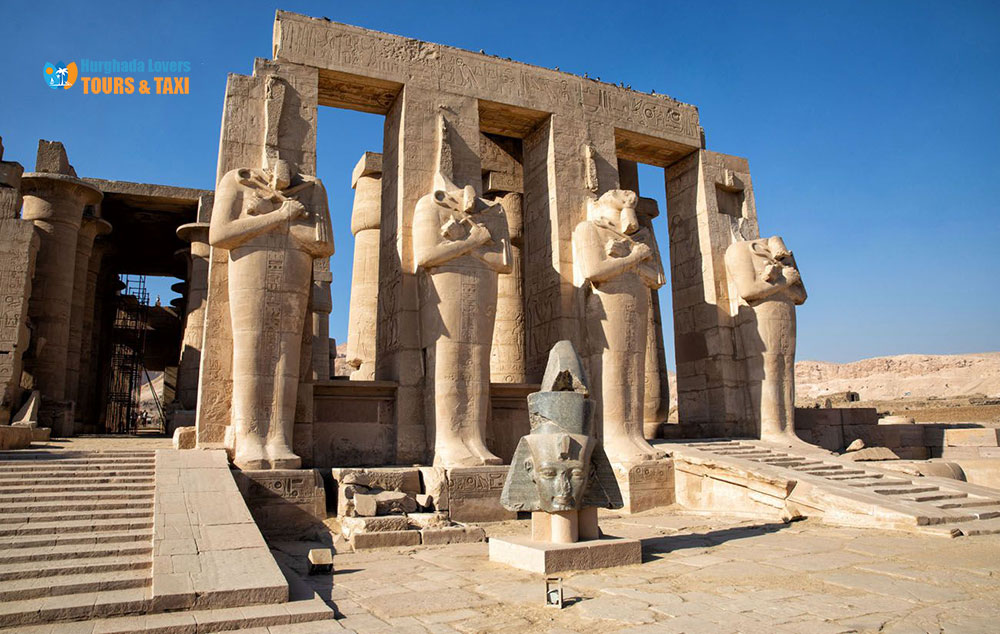Temple of Ramesseum in Luxor Egypt | Best Things to Do in Luxor & Facts Funerary Pharaonic Temples of King Ramses II.
The Temple of Ramesseum in Luxor, Egypt | The most important funerary Pharaonic Temples of King Ramses II “Egyptian Pharaohs kings” and what are the secrets and History Of Egyptian & the construction of the temple, inscriptions and pharaonic drawings discovered to tell us the culture of the Pharaonic Civilization & Things to Do in Egypt.
Hurghada lovers Offer Luxury Hurghada to Luxor Tours | El Gouna to Luxor Tours | Makadi bay to Luxor Tours | Sahl Hasheesh to Luxor Tours | Soma bay to Luxor Tours.
Temple of Ramesseum in Luxor Egypt – Temples of King Ramses II
Type of temple: funerary temples
Area: 130,000 square feet.
Date of construction: 1292 to 1225 B.C.
Length: 180 m
Width: 66 m
The temple is surrounded by a large brick wall 270 meters long and 175 meters wide.
Who created the temple?
King Ramses II.
What is the reason for the construction of the Temple of Ramesseum?
- The main purpose of the temple was to show the king’s strength and status throughout history and among the kings of the Pharaohs, who are considered the greatest building kings who built temples.
- The temple was dedicated to the worship of God Amun.
Temple Names and Titles:
- Khenmet Wasset a name that means united to Wasset (Luxor) in the Egyptian language.
- Memnonium in the Greek language
- Ousser Maat Ra or Wesser Maat Ra along the pharaonic history
- The Temple of millions of years of Ramses II.
How important is the Temple of Ramesseum?
Many pharaonic papyri have been discovered on the site of the temple in the secret warehouses of the temple that tell the secrets of the Pharaonic civilization such as the Senouhi papyrus.
You can easily reach the temple by a path between The Colossi of Memnon and the pier on the west bank of the Nile, but unfortunately, most of the temples have been destroyed due to erosion and climatic conditions through the age.
The temple is named after Greek civilization as “Memnonium” and the cemetery of Osmendias, where the name belongs to the Ethiopian hero Memnon ben Titons and Ayus with the huge statue in the temple.
The name of the temple as the tomb of Ozimandias Ayus due to the distortion of the word Usser Maat Ra, which is the coronation name of the king, and inscriptions and pharaonic phrases have been discovered on the colossus of Memenon in the temple “Me Ozimandias, king of kings if anyone wants to know to which point I am great, and where is my resting place (tomb), let him come to see my greatness in my work:.
The funerary temple measures 600 feet by 220 feet, with an area of more than 130,000 square feet.
The interior plan of the temple of Ramesseum:
When you begin your tour to see this distinctive archaeological site, you will find a large pylon on the east side at the entrance to the first courtyard of the funerary temple, then drawings and inscriptions considered part of the Syrian military campaign led by King Ramses II in 1288 BC.
The battle was drawn for the king as he fought the army of the Hittites himself and defeated them at the Battle of Kadesh on the Orontes River in the fifth year of the king’s reign over Egypt, where it is considered one of the most famous battles and victories of the ancient Egyptian civilization of the pharaohs found in the temples of Luxor on the west bank.
You will find drawings on the north tower of the pylon the names of 18 cities occupied by King Ramses II, as well as inscriptions for prisoners of war and other drawings until you find yourself in front of the south tower.
You will find that the first courtyard of the temple is demolished 90% due to the climate and erosion conditions, and you will find on the west side of the courtyard a collection of pharaonic statues remaining so far but in ruins.
When you go to the second courtyard of the funerary temple, you will find two rows of round columns, and on the east side a row of square columns on which the statues of Osiris, and on the west side a row of Osirian columns of square shape facing the courtyard directly located on a high balcony, then a row of columns with papyri form capitals form buds of the papyrus plant.
Over time, the Osirian statues have disappeared, 4 statues per row of Ramses II, where one of the well-known historians, Diodorus, “is supported instead of square columns by animals, each carved from one block of stone of 16 arms high, carved in the old way.
As you head to the west side of the Temple of Ramesseum, you will find pharaonic drawings and scenes of King Ramses II kneeling in front of the triad of Thebes, and on the left, King Ramses II depicted with Monthu the god of war and the god Atum, then drawings of the sons of King Ramses II and then at the top a scene for the king presenting offerings to the gods. Min, Ptah and other Gods as the pharaohs once believed.
The Hypostyle Hall of the funerary temple:
The Hypostyle Hall has 3 huge doors at the end of the three steps and is of the same architectural concept as the Great The Hypostyle Hall in the Karnak Temple.
You will find inscriptions on the west side of King Ramses II attacking the city of Galilee as he climbs on his war chariot with victorious horses on the ennemis, on the other side you will find inscriptions of King Ramses II receiving the sign of life of Amun next to Khonsu and Mut in addition there are one of the most important scenes engraved on the walls of the most Important temples in Luxor built on the west bank the scene that depicts the sons of King Ramses II.
The Hypostyle Hall of the Temple of Ramesseum:
When you enter the hypostyle room, you will find the roof held on 8 papyri form columns with capitals engraved in the form of pharaonic papyrus buds, in addition to the drawings and inscriptions of the king with the gods.
On the side you will find inscriptions of the procession of the sacred boats of the Theban Triad, then on the west wall a scene of King Ramses II sitting under the branches of the tree of life, the gods Thot and Seshat who are writing the name of the king on the leaves of the tree of life to immortalize his name.
You will then find a vestibule behind the second hall but they are 100% demolished, where you will find 4 columns with pharaonic designs and inscriptions in addition to the old buildings, mud brick deposits from the time of the Pharaonic king Ramses II.
You will find the temple of Prince Izmosis, son of the Pharaonic king Thutmosis I of the 18th dynasty south of the temple of Ramesseum, archaeologists found paintings and statues in the temple and transported them to the Luxor Museum and from there to the Egyptian museum “Museums of Egypt“, in addition to the ruins of pharaonic buildings south of the temple that date from the time of King Thutmosis IV father of King Amenophis III located on the west bank of the Nile in Luxor.
As you head south, you’ll find the temple of Queen Ta Usseret, daughter of the Pharaonic king Saptah of the 19th dynasty, but the temple is largely destroyed in a small area of silt and gravel from the Nile, archaeologists explain that Queen Ta Usseret the queen of Egypt after the death of King Saptah.
When you leave the temple of Queen Ta Usseret and head south, you will find the funerary temple of the Pharaonic king Merenptah son of Ramses II, but unfortunately, over time, much of the temple was demolished, where it was two-thirds of the area of the temple of Ramesseum.
In the temple you will find a spacious courtyard, then a courtyard containing Osirian columns, then two rooms with 12 columns and the other with 8 columns, then many rooms behind the two rooms.
In 1896, the famous archaeologist Flinders Petri found a granit Stella of King Merenptah with words indicating the victory of King Amenophis III.
About King Ramses II:
Reign: 1279-1213 BC.
Date of birth: 1300 BC
Date of death: 1213 BC
Pharaonic dynasty: 19th dynasty
Royal wives of the King:
- Nefertari
- Isset Nefert
- Maat Neferou Ra
- Merit Amon
- Penet Enat.
- Nebet Tawi.
- Henout Mi Ra
Children
- Amon Her Khepesh ef
- Prince Ramses
- Khaa Em Wasset.
- Merneptah
- Mery Atoum
- Penet Enat.
- Merit Amon
- Nebet Tawi.
Father: King Sethi I
Mother: Queen Touya
Burial place: Tomb 7 in the Valley of the Kings in Luxor
Buildings:
- Temple of Abu Simbel
- The Temple of Abydos
- Temple of Ramesseum
- Luxor Temple
- Temple of Karnak.
Works of King Ramses II:
- Conduct military campaigns for the land of Shalam to Canaan and defend the southern borders of Egypt to Nubia.
- Construction of the city of Per Ramses in the Delta region on the Nile
- Built temples and monuments all over Egypt
- His time was marked by prosperity and stability.
The address of the Temple of Ramesseum:
The Necropolis of Thebes, West Bank, Luxor, Egypt
Dates of visit to the Ramesseum Temple:
Sunday: 9am to 5pm
Both: 9am to 17am
Tuesday: 9am to 5pm
Wednesday: 9am to 5pm
Thursday: 9am to 5pm
Friday: 9am to 5pm
Saturday: 9am to 5pm
Ticket prices for the Ramesseum Temple:
Egyptian entrance ticket price = 10 Egyptian pounds
The price of the entrance ticket is an Egyptian student = 5 Egyptian pounds
Entrance ticket price for foreign tourists = 60 Egyptian pounds
Entrance ticket price for foreign students = 30 Egyptian pounds
Hotels near the Temple of Ramesseum:
- Hotel Alaska
- Hotel Karim
- Hotel Cleopatra
Author & Writer Temple of Ramesseum: Tamer Ahmed Abd elfatah Yousif
The Temple of Ramesseum in Luxor, Egypt | The most important funerary temples of King Ramses II


